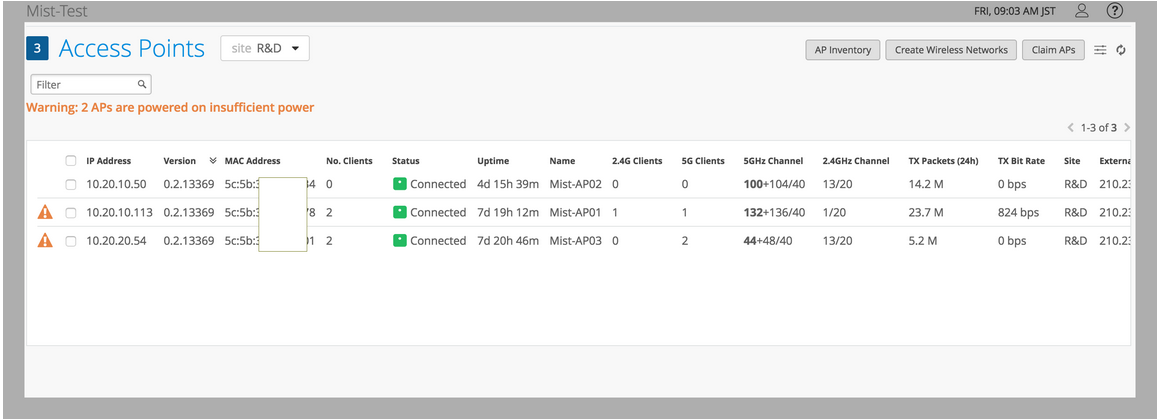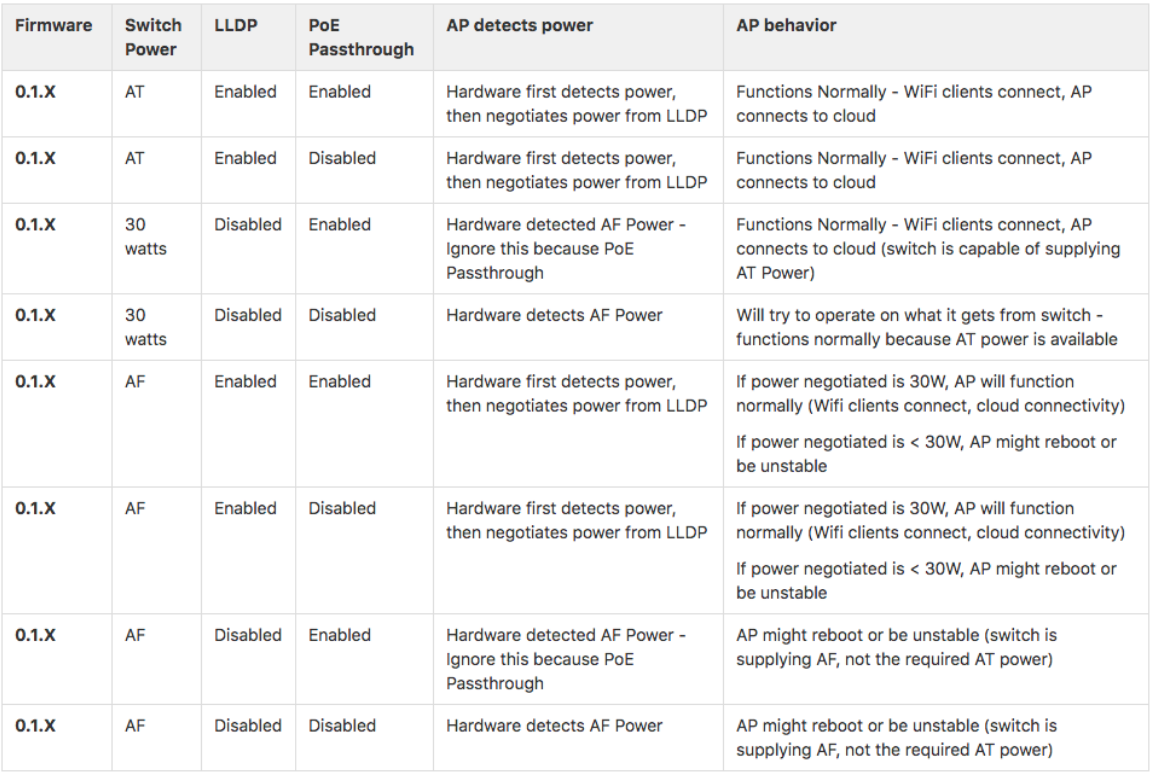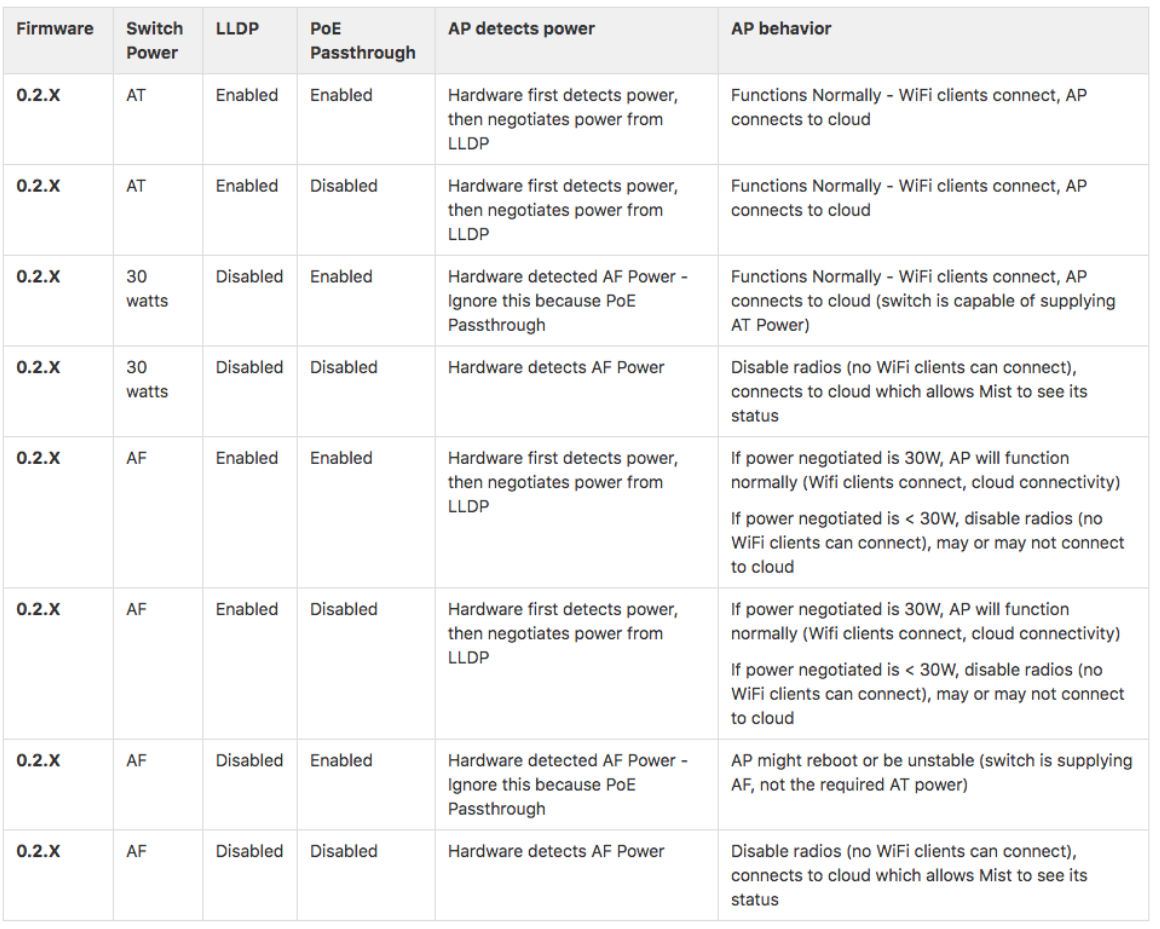| Generation | Model | Minimum PoE Required | Wattage Required for Full Wi-Fi Functionality |
| Wi-Fi 6E | AP64 | 802.3af | 13W |
| AP45 | Dynamic | 29.3W | |
| AP34 | Dynamic | 20.9W | |
| AP24 | 802.3af | 13W | |
| Wi-Fi 6 | AP63 | 802.3at | 25.2W |
| AP43 | 802.3at | 25.5W | |
| AP33 | 802.3af | 19.5W | |
| AP32 | 802.3af | 19.5W | |
| AP12 | 802.3af | 12.9W | |
| Wi-Fi 5 | AP61 | 802.3at | 19.5W |
| AP41 | 802.3at | 19.5W | |
| AP21 | 802.3af | 12.9W | |
| Other | BT11 | 802.3af | 5.5W |
- The AP45 requires 802.3bt for full functionality. On 802.3at it has dynamic functionality based on what is configured
- The AP will do 4×4 on any two data radios, or 2×2 on 2.4 GHz, 4×4 on 5 GHz, and 2×2 on 6 GHz with three data radios enabled. For example:
- If your WLAN configuration only has two bands configured, the AP will operate as 4×4 on both of the data radios.
- If WLAN configuration has three bands configured, which means all three data radios are active, then the AP will operate as 2×2 on 2.4 GHz, 4×4 on 5 GHz, and 2×2 on 6 GHz
- Note: If Dual 5 GHz is enabled, that also means all three data radio are active and the AP will operate the same as the previous scenario (2×2+4×4+2×2).
- The dedicated scan radio and BLE are always active regardless of power.
- The AP will do 4×4 on any two data radios, or 2×2 on 2.4 GHz, 4×4 on 5 GHz, and 2×2 on 6 GHz with three data radios enabled. For example:
- The AP41/43 requires PoE+ or 802.3at power, and it consumes a maximum of 25.5W. Thus, always connect an AP41 or AP41E, AP43 or AP43E to an 802.3at or PoE+ switch.
- The AP34 requires 802.3at power for full functionality. 802.3af mode is only used to connect to the cloud and let you know the APs needs more power.
- The AP24/64 require 802.3af power for full functionality
- The AP33/32 require 802.3at power for full functionality, however they are capable of running on 802.3af power in reduced state. The 5 GHz radio will reduce from 4×4 to 2×2, eth0 will operate at max 1 Gbps, and eth1 will be disabled.
- The AP12 requires 802.3at power only when PoE out functionality is used. If PoE out is not required, the AP12 can fully operate under 802.3af power.
Please note:
- Note – Most Cisco switches won’t provide more than 802.3af power unless negotiated via CDP or LLDP. LLDP is disabled by default on most Cisco switches so the AP will not receive enough power. LLDP can be enabled on the switch or on specific interfaces.
- Depending on your switch vendor, you may also need to enable 802.3bt mode explicitly.
- On Cisco support for 802.3bt mode was added in IOS-XE 16.12.1 on many capable platforms via the command hw-module switch upoe-plus
Firmware numbered 0.2.13369 or later will provide a warning in the UI if the AP is operating under 802.3af (15W) power.

AP Behavior with AF and AT Power
Simple rules:
- Either LLDP or override tells the AP what power is available
- The override is ignored once LLDP is heard
- Without override, we use the hardware detection to determine what power is available
- LLDP overrides everything
Operational Flow of the AP:
- AP45/43/41/34/33/32/12 Powers up and uses hardware detection to detect either AF or AT power. The AP45/43/34 will also detect BT power.
- The AP boots and assuming LLDP is enabled, it hears LLDP advertisement from the switch and learns the capabilities of the switch. One of the capabilities is the amount of power available.
- The AP will ask the switch for 19.5 Watts (which equates to 25.5 Watts on the switch to compensate for 16% line loss).
- The Switch will announce how much power it actually can provide, which should be 25.5 Watts now. NOTE: If they statically set the switch to 30 Watts, then this advertisement will be 30 Watts.
- The AP is now happy, because it has all the power it needs, so it will NOW enable all the radios.
Conditions for Insufficient Power Alert on AP Page
- If AP41/43/33/32 is unable to receive 19.5 Watts from the switch (which equates to 25.5 Watts on the switch to compensate for 16% line loss).
- If AP41/43/33/32 is connected to an AT capable switch and has LLDP disabled (This case is valid for only Cisco switches)
- If AP41/43/33/32 is connected to an PoE Injector with less 25 Watts capability.
Change in behavior in 0.2.X Firmware vs 0.1.X Firmware and earlier:
In 0.1.X and earlier, the AP would try to operate on any power. If the power was less than 802.3at (30w), the behavior of the AP was inconsistent. It may or may not connect to the cloud. It may or may not serve wifi clients. The bigger problem was that in case it did not connect to the cloud, it was a problem to troubleshoot the issue.
In 0.2.X, if the power to the AP was less than 802.3at, the AP will disable the radios BUT will still connect to the cloud. As the radios are disabled, no wifi clients can connect to the AP BUT as the AP is connected to the cloud, troubleshooting is easier as we can clearly see in the AP logs that it is not getting 802.3at power.
Example operational scenarios:

